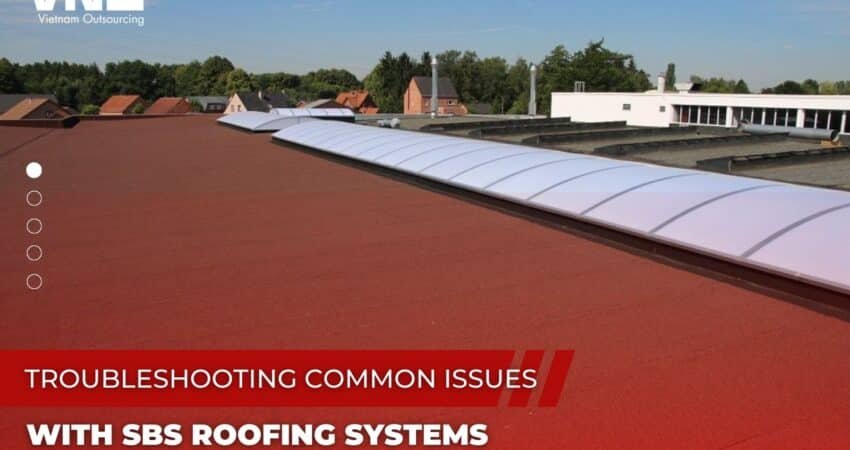SBS (Styrene-Butadiene-Styrene) roofing systems have acquired popularity in the construction industry due to their exceptional weather resistance and durability. However, as with any roofing material, SBS roofs may experience problems over time.
This exhaustive guide will examine the most common issues with SBS roofing systems and offer practical troubleshooting advice. Whether you are a property owner, constructor, or roofing professional, it is imperative that you are aware of these issues and their solutions to ensure the durability and optimal performance of your SBS roofing system.

1. Flaring and Erupting
The formation of blisters and bubbles on the surface is one of the most common problems SBS roofing systems encounter. These sores and bubbles result from air or moisture trapped beneath the roofing material.
Inspect the afflicted areas thoroughly and mark the blisters’ locations to treat blistering and bubbling. Then, using a utility knife, make small incisions along the margins of the blisters to release any trapped air or moisture. Apply roofing cement to the incisions, then press the lesion down to ensure proper adhesion.
2 . Stagnant Water
Ponding water refers to the prolonged accumulation of water on the surface of a roof after rainfall. It occurs when the top does not have adequate drainage or slope.
To eliminate ponding water, ensure the roof’s drainage system is free of obstructions and detritus. Improving the roof’s slope and installing roof drainage or scuppers can also help prevent ponding by redirecting water away from flat areas.
3 . Splitting and Cracking
Due to exposure to fluctuating temperatures and the elements, SBS roofing systems may develop fractures and fissures over time.
Regular inspections are necessary to detect fractures and splits in their earliest stages. Once the damaged areas have been identified, use SBS roofing patching compound or sealant to repair them. Follow the manufacturer’s instructions for application to ensure a proper and durable repair.
4. Wind Uplift
SBS roofing systems are susceptible to wind uplift, particularly in regions with frequent high winds. Wind uplift can cause roofing materials to become loose or dislodged, jeopardizing the integrity of the entire roof.
Install mechanical fasteners and reinforcements at the roof’s margins and corners to bolster the roofing system’s resistance to wind uplift. In addition, using heavier roofing materials or adhesive bonding can increase the roof’s resistance to wind uplift.
5. Flickering Problems
Flashing is essential for preventing water infiltration at roof penetrations and joints. Flashing that is damaged or inadequately installed can cause leaks and water damage.
Flashing around roof penetrations such as chimneys, ducts, and skylights should be routinely inspected. Repair or replace deteriorated flashing and ensure proper sealing using roofing cement or sealant.
6. Thermodynamic Expansion and Contraction
SBS roofing systems can expand and contract in response to temperature fluctuations. This repeated movement may strain the roofing material, leading to potential problems.
Choose SBS roofing materials of superior quality designed to withstand thermal stresses. Install the roofing system with sufficient expansion joints to accommodate thermal expansion and contraction without causing damage.
7. UV Degradation
Problem: Prolonged exposure to UV radiation can degrade SBS roofing material, resulting in surface deterioration and diminished performance.
To protect the roofing material from UV radiation, apply UV-resistant coatings or reflective roof coatings. Regularly inspect the roof’s surface for signs of UV degradation and reapply layers as needed.
8. Inadequate Insulation
Inadequate insulation can result in energy loss and temperature fluctuations inside a building. In frigid climates, it can also contribute to the formation of ice dams.
Ensure the SBS roofing system has adequate insulation to increase energy efficiency and prevent ice formation. Consider adding more insulation if necessary.
Conclusion
SBS roofing systems provide exceptional durability and weather resistance but may experience problems over time, as with any roofing material. By comprehending and addressing these common issues, you can maximize the performance and longevity of your SBS roofing system. Regular maintenance, proper installation, and timely restorations are required to ensure the durability and dependability of your property’s roofing system. Remember to consult with roofing professionals for complex issues and extensive repairs to provide the best results for your SBS roofing system.
Contact VNO now:
- Website VNO: https://vnoutsourcing.com/
- Email: info@vnoutsourcing.com


